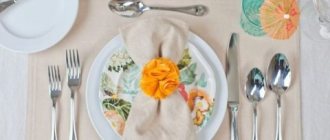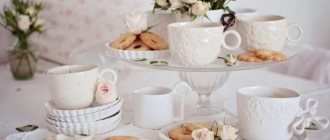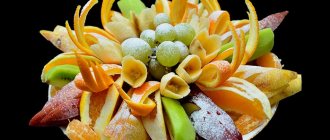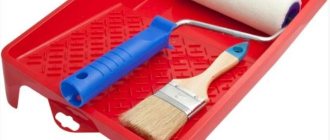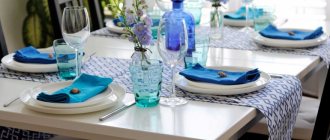Tired of monotony? Perhaps you spend this time in front of the TV? Why, if you can turn an ordinary morning into a small pleasant holiday. To do this, it is enough to understand the rules of table setting.
Today I will tell you about the history of serving, the correct technology, we will analyze the diagram and look at several illustrations of the design of a breakfast table.
History and development of the art of table setting
People began to eat noble meals already in Ancient Rome. Rich citizens consumed food while lying down. It was previously believed that eating foods this way improved the functioning of the digestive system. Slaves brought a three-legged table with goodies to their masters' bedside. It had something like a modern knife and spoon on it. These devices were silver or gold.
In Europe, people began to set tables for food only in the 14th-15th centuries.
Reference! When delicate porcelain dishes were already being produced in the East, clay and wood were being made in Europe, and cutlery was considered a luxury item.
When beautiful dishes were brought to European countries, this etiquette began to develop. This is how the initial requirements appeared: the table had to be covered with cloth, there had to be a vase with flowers in the center, and a cup of water for washing hands near the plates.
Over time, etiquette has evolved. In the 18th century, porcelain production appeared in Germany. They began to produce separately plates for various dishes, dessert plates, knives, spoons and forks.
Eating etiquette develops among the nobility. During the rounds, napkins are used, and the serving procedure takes on a new look.
Folding napkins for table setting
Napkins are an integral attribute of any feast. No matter how beautifully folded paper or linen napkins are, do not forget that they, first of all, serve for the convenience of guests.
Therefore, any napkin should be located in the most accessible place, and even the most intricate napkin figure should be easy to unfold.
The pictures show how to quickly and beautifully make a flat or three-dimensional figure from a napkin.
Folding
a napkin into a Christmas tree shape
Volumetric folding of a linen napkin
Beautiful folding of a napkin for table setting
The shut -off Calvet boom in the species for cords
is important: the volume figures from the tangled CALPHT will be kept to hold on, and the CAMSIMS OF CALLETS OF THE CAMS Mailed.
To starch a linen napkin:
- Add 1.5 tbsp to 0.5 liters of cold water. starch and stir until you get a homogeneous cloudy white solution that does not contain lumps.
- Boil 1 liter of water, pour into the prepared solution and mix.
- Cool and strain through cheesecloth.
- Dip clean dry napkins into the solution and squeeze a little.
- Hang the napkins to dry without using clothespins.
- Start ironing between two towels as soon as all the water has drained from the napkins.
IMPORTANT: According to the rules of etiquette, beautifully folded napkins should be used at formal feasts. For other events, napkins can simply be carefully placed in a glass or stand.
Technology of proper table setting for breakfast
Before arranging plates and spoons correctly, you need to know a few simple serving rules.
1. The tablecloth is the basis of the basics. We cover the table with a tablecloth. The main requirement for it is smoothness and impeccable cleanliness. Do not forget that the color of the tablecloth should be in harmony with the overall interior of the kitchen.
Note! The tablecloth runner is gaining popularity. This is a thin woven strip. It is placed in the middle of the table. It covers one third. A runner is a rectangular and square element. No one canceled the napkins. The pattern must be the same on both elements.
2. Large flat plate. This element should be at the center of the entire structure. The dishes are used for hot dishes (fried eggs). When porridge is served for breakfast, this element becomes a sub-plate. A deep hoop for food is installed on it. As for patterns, it's completely up to you.
In the proposed photo, a large plate plays the role of a plate:
3. Cutlery. This is the next stage of serving. A knife is placed on the right side of the plate, with the tip facing the dish. Next comes a tablespoon, and then a teaspoon. If there is a fork, it should be placed to the left of the plate. There should be a napkin to the left of the fork.
Note! If a tablespoon is not provided, but there should be a dessert spoon, then it is placed above the main plate. The handle of the dessert spoon should point to the right.
4. Drinkware. Mentally draw a diagonal from bottom to top from left to right. At the top right there should be a coffee cup, which stands on a saucer and a spoon.
5. Sandwiches. The small plate for this dish should be slightly to the left of the center line of the large plate. The knife should lie on the sandwich saucer with the blade to the left.
6. Sugar, jam and lemon. The first element is served in a sugar bowl. If you have a piece, then you must have special tweezers. Jam or jam should be poured into special bowls with spoons. The lemon is cut into portions and placed on a bowl. There should be a small fork nearby.
To complete the overall composition, place a small bouquet on the table. Further in the section, a selection of interesting ideas, you will find some amazing compositions with flowers.
Basic rules for serving tableware
Plates are placed on the table first, and glasses, shot glasses, glasses - last. Arrange the plates in this order:
- the middle plate (snack) in such a way that there is 2.5 - 3 cm left to the edge of the table.
- the pie (bread) plate on the left, leaving about 10 cm.
- If you plan to change dishes, place a small dinner plate under the snack bar, first placing a napkin under it.
IMPORTANT: Depending on the type of first dish, choose a plate for it. If cream soup or broth will be served, take a bowl; if thick soup or borscht, take a large deep plate.
- Place the wine glass on the right, the water glass on the left, but they must be in the same line.
- Two rows of drinkware are allowed if a grand event with a large number of different dishes and drinks is being prepared.
IMPORTANT: Dishes for serving the table must be prepared in advance. To do this, wash it, dry it, and wipe it thoroughly with a towel. The main thing is that the dishes look impeccable before serving. Smears, drips, cloudy or opaque appearance are unacceptable.
Breakfast serving plan
The requirements described above are only general conditions for table setting. You can complement the composition with various elements.
As you can see, this diagram also includes a glass for juice and milk or water. However, this arrangement is used for everyday meals. If you are expecting guests, then you need to be more responsible here.
According to the etiquette of a formal meal, there should be a snow-white tablecloth on the table. Light decor in pastel shades is allowed. The situation with napkins is similar to that described in the previous section.
As for tableware, serving breakfast when guests arrive means using crystal, nice tableware and clean white dishes.
In the center there must be a composition of flowers and dishes that are not laid out individually for each person:
- main course;
- salad bowls;
- a vessel with a drink (water or juice);
- socket with jam;
- sugar.
Salt and pepper shakers should be placed at each place. The rest of the arrangement of plates, cutlery and glasses is similar.
Decorating the table before guests arrive can be schematically described as follows:
- A cloth napkin is prepared individually for guests;
- A large flat plate is placed on it, with a salad bowl on top;
- knife - on the right with the tip towards the plate, fork on the left;
- a teaspoon is placed to the right of the knife, and another snack bar is placed to the left of the fork;
- A pie fork is placed above a large plate, with a dessert spoon next to it;
- Drink glasses are placed diagonally to the right.
A more detailed location can be seen in the video provided:
Rules for setting the table for dinner according to etiquette
Dinner, whether invited or a quiet family dinner, is always associated with warmth and comfort. Therefore, it is important for the hostess not only to set the table correctly, but also to complement the setting with appropriate details.
- Choose a tablecloth (suitable with a small pattern).
- Place two small plates, one inside the other, and to the left of them place a plate for bread.
- To the left of the plates, place the forks with their tines up, and to the right, place the knives with the blades facing the plate.
- Place dishes for alcoholic drinks to the right of the plates, for water - to the left.
IMPORTANT: Table setting for dinner is similar to dinner setting, but differs in the absence of a deep plate and spoon for the first course. This dish has no place on the table in the evening.
A selection of interesting ideas
Look at the illustrations provided. A number of photographs slightly violate the basic rules of table setting, but this is not a problem. After all, you are at home. You are an artist in your kitchen. Create, and we will help you.
With our tips and detailed illustrations, you will be able to create an amazing composition for a seemingly ordinary breakfast. Our serving rules will help you create a positive mood for the whole family for the whole day.
Try, experiment and surprise with tips from “Simply SMAK”.
Design tips
The decoration of the table for the first meal depends on several factors: the well-being of the family, the daily routine of the household, traditions and taste preferences. To please your loved ones with a pleasant start to the weekend, try setting the table for a classic breakfast. And the designers' advice will help you do it right:
- Choose a tablecloth and napkins in the same/similar design. Textiles will help create a single composition, designed in the same style.
- Choose a central composition. It's about decor. This could be a vase with fresh flowers, a basket of fruit, an antique samovar and more.
- Glasses and glasses made of colored glass. Such dishes create a festive atmosphere. Well, how long can they gather dust on the shelf? Why not have a party every day?
- Try to choose themed decorations. For example, for a Sunday breakfast in winter, you can decorate the table with artificial snow, snowman figures, fir cones and other accessories that create a New Year's mood. A vase with spruce branches will fill the house with a magical aroma.
Whatever the table setting for breakfast, the main thing is that all relatives and friends look forward to the moment when the whole family will be together.
Dessert time
Dessert is served at the end of lunch. Before serving the final course, be sure to remove unnecessary utensils from the table. Spices, tableware and used napkins should not be left on the table. Only drinks and flowers remain in the center of the tabletop. Remove trash after eating using a small dustpan with a lid and a folded napkin.
The word “dessert” itself has French roots and literally means cleaning the table. At family dinners, pies or sweets are often served with tea. In this case, serving is reduced to a tea set and vases for treats. When serving the pie, place a dessert plate in front of everyone. When serving a festive dinner, if necessary, bowls with dessert are placed on top.
Rules for serving a banquet table
Banquets are held in honor of any major holiday, for example, an anniversary or a wedding. The very concept of “banquet table” implies that the event will take place in a specially rented banquet hall, and waiters will serve the guests.
The attributes of the banquet are:
- various decorations (balloons, bows, special drapery)
- entertainment for guests (live music, performances, toastmaster or party host)
The banquet table should correspond to the situation, occasion and general mood.
The main rules for serving it:
- Folding tables are used, which are arranged depending on the number of guests, the features of the room, and the type of service.
- The tables are covered with white banquet tablecloths, leaving about 25 cm from the edges.
- First, small plates are placed. They are positioned in such a way that the distance between adjacent plates is at least 60 cm, but not more than 80 cm, and the distance to the edge of the table does not exceed lo 1 – 2 cm.
- Snack plates are placed on top, and pie plates are placed on the left.
- Knives are placed on the right with their blades facing the plates. All utensils located on the right: table knife, fish knife, table spoon, snack knife.
- To the left of the plate: a table fork, a fish fork, two snack forks.
- The dessert fork and knife are placed behind the plate.
- There is also a wine glass behind the plate, and to the right of the wine glass there are glasses for stronger drinks.
- Fabric napkins are placed on plates, after giving them a beautiful appearance.
- Low flowerpots with fresh or artificial flowers are placed evenly in the center of the table.
- Vases with fruits and grapes can also serve as table decoration.
IMPORTANT: Every little detail is important for a banquet table, so serving takes a lot of time.
Additional devices
Not always table setting comes down to the traditional version: a lot depends on what dishes will be served, because some of them require additional utensils that simplify the eating process.
- When serving snacks or just cold dishes, a snack device is used - a lightweight version of a small dining room. Of course, there is no spoon in such a device, and the fork and knife are smaller in size, and the knife can be serrated.
- If you are going to eat hot fish dishes, according to the serving rules, there should be a special fish utensil on the table - a fork with a recess for removing bones and a dull knife with a spatula.
- The dessert fork is even smaller than the snack fork. Like the small cutlery, the dessert one contains a spoon, but of a much smaller size. But it can be used not only when serving desserts and sweets, but also for broth or fried eggs.
- The smallest fork and knife together make up a fruit utensil. The fruit knife must be sharpened.
- The scope of use of tea and coffee spoons is clear from their names; the first one is slightly smaller than the second one.
- The salad spoon is larger than a soup spoon.
- To prepare cocktails, use a spoon with a long handle. To some extent similar to a spoon and caviar spatula.
- Dessert is transferred with a special spatula, flour sweets - with pastry tongs, main courses - with tongs from a fork and some kind of spoon.
- Ice tongs are made of stainless steel or cupronickel. Tongs with flat corrugated teeth are used for chopping nuts.
- The oyster fork has the shape of a trident, one of the teeth of which is made in the shape of a can opener.
- A double-horned fork is designed for lemon wedges (usually accompanied by a knife with a zigzag edge).
- A hybrid fork-spatula shape is designed for canned fish.
- For cheese, a special knife-fork is used.
These photos show how to set a table with additional cutlery:
Auxiliary accessories
If we continue the theme of tea drinking, it is worth mentioning everything necessary for serving the cake. If tea drinking ends a dinner party, then all the dishes are first removed from the table. Dessert cutlery is placed in its place. The cake is brought out on a tray or vase on a leg. The vase can be with or without sides. The dish, as already mentioned, is pre-cut into portions. The only exception is a wedding, where the newlyweds cut the cake in the presence of guests.
Use a pastry spatula to place dessert on plates. Although it belongs to the auxiliary accessories, it is not at all secondary on the festive table. It’s good if the spatula is in tune with the rest of the cutlery. It can be combined stylistically with a vase or with cups and saucers. And although cakes with a soft base can be eaten with either a dessert spoon or a fork, the second option is still more convenient.
The list of serving accessories can be short, or it can be long - depending on what goals the owners are pursuing and what level of reception they are organizing. Restaurants must use all utensils required by etiquette. At home, the system is simplified.
Auxiliary accessories by type of device.
- Spoons. In addition to the main spoons, you can stock up on a scoop spoon for sauces and a scoop spoon for granulated sugar. This also includes a caviar spatula and an ice cream spoon.
- Forks. Serving a special herring fork with two prongs, as well as a salad fork with three prongs, will be effective. You can also stock up on a julienne cocotte fork - it is very elegant.
- Knives. In addition to the basic ones, you can expand your arsenal of cutlery with a knife for butter, cheese and berries and fruits.
- Forceps. In addition to the tongs already mentioned above, you can get tongs for ice, green beans and lobster.
Of course, many people start learning table etiquette from the plates. If you are sure that you already have different types of them, check to see if the menu plate, egg plate, rosette and bowl are included in this list. Perhaps there is still some work to be done.
Examples of proper serving are numerous thematic photos. Observe how the experts handle the table setting, what design the cutlery can be, and how they look on the common table.
To learn how to use cutlery correctly, watch the following video.
Informal receptions
Table setting for an informal reception is more democratic. However, there are also some rules that need to be taken into account: the availability of space for the reception, the style of your home, the occasion for which you are organizing the reception, and the tastes of your guests.
If you take these circumstances into account, you can give free rein to your creative imagination when setting the table.
Therefore, you can put colored napkins on the table, choose the appropriate color scheme for the main table decoration, as well as for porcelain or ceramic dishes.
Usually in such cases the table is covered with a colored tablecloth or a tablecloth with a printed pattern, or a waterproof napkin is placed in front of each guest on which the dishes are placed.
If you have a set of linen, lace, straw or woven table napkins and hand wipes, it would be very appropriate to give them to guests.
However, whatever you decide to cover the table with, make sure the centerpiece and china will coordinate with the napkins or tablecloth.
At the same time, try to give the table originality and unique personality, reflecting your own ideas about successful table setting.
They can be of any color that harmonizes with the tablecloth or with the napkins laid out on the table, but the main thing is that the candles are located at a sufficient height and do not blind the eyes of diners.
The hostess (in some cases she is helped by one of the guests) removes the candles after the end of dinner.
Wide red stripes on a white tablecloth and large red poppies in a vase in the center of the table will greatly liven up the atmosphere of your reception, especially if it is held in winter.
You shouldn’t limit yourself to an ordinary vase of flowers, even when they look beautiful.
As at an official reception, all devices for guests should be located symmetrically and at the same distance from one another.
Most often, wine is offered in one type, less often - two, so a water glass and one or two glasses for wine are placed in front of each guest.
It happens that wine is not served at all, in which case glasses for iced tea or just water or beer mugs are appropriate.
A spilled piece of butter or a slice of bread lying on your plate, generously flavored with fish sauce and decorated with salad peas, will not look very aesthetically pleasing.
For the same reason, clean plates should be served with the salad if guests have previously eaten a dish generously topped with gravy.
If guests are invited to an informal three-course dinner, the following utensils are usually placed on the table before each of them:
- 2 forks (the one on the far left is for a hot dish served at lunch, and the one closest to the plate is for dessert or salad)
- dinner plate
- Salad plate (to the left of the forks)
- 1 knife (next to the plate on the right - for steak, chop, chicken or game; usually called a "steak knife")
- 2 spoons (dessert spoon - to the right of the knife, for soup - even further, to the right; you, of course, remember that the utensil lying closest to the plate is used last)
- 1 saucer with butter knife
- 1 wine glass or tall glass for water
- 1 wine glass
- An ashtray, even if no one smokes
- Napkins in the center of the table
If you are going to serve coffee at dinner, the cup and saucer should be placed to the right of the person sitting at the table, and the coffee spoon should be to the right of the saucer.
At an informal dinner, serving plates are not placed, except when the first course is served with shrimp cocktail, fruit cocktail and other dishes, which are usually poured into a wide glass goblet with a stem, or soup.
It is not necessary to place a dessert spoon and fork (you can limit yourself to just a spoon) next to the plate.
As at a formal dinner, they can be brought along with the dessert plate or, according to European tradition, placed horizontally in the center in front of each guest, to the right of the glasses and cups!
These photos show what dishes and cutlery look like for proper table setting:
General rules
Below are some general recommendations on how to set the table beautifully and correctly:
- It is recommended to set the table with identical cutlery and dishes of the same style and color.
- In front of each chair there is a serving plate on which a plate of appetizers is placed.
- A snack plate is placed opposite each chair so that the distance from the edge of the table to the plate does not exceed 2 cm and is not less than 1.5 cm.
- On special occasions, appetizer plates are placed on small table plates. Moreover, a paper napkin is first placed on a shallow plate to avoid slipping. On the left side, place a plate for bread (pie) so that the lines of the center or edges of the plates coincide.
- The distance between plates should be approximately 60 cm, the distance between plates and cutlery, as well as between the cutlery itself - 0.5 cm.
- Before placing the plates on the table, it is not enough to simply wash and wipe them; you need to polish the plates until they shine with a kitchen towel.
- Never forget about napkins! Starched fabric, folded into a triangle, a cap or in some other way, “mandatory serving attributes,” are placed on a plate or to the right of it - under a knife and spoon. We place paper napkins in vases or special cups in two or three places on the table. Cutlery is laid out immediately after arranging the plates. Next to the serving plate and a little higher, place all the forks and knives that may be needed during meals.
The general rules of table setting according to etiquette dictate putting no more than three forks and three knives, since all cutlery is not used at the same time.
Knives are placed to the right of the plate depending on the lunch or dinner menu in the following order: large dinner knife, fish knife, small appetizer knife.
Knives should be pointing towards the plate.
If it is expected that soup will be served at lunch, then place a tablespoon with the convex side down between the snack bar and the fish knife.
The forks are placed to the left of the plate with the tines facing up. Closer to the plate is a large dinner fork, then a fish fork, and finally a small appetizer fork.
The utensils must be used in accordance with their location, starting from the outermost ones and ending with those located next to the plate.
If you stop using the device from time to time, then place it only on the edge of the plate, but in no case on the tablecloth.
If you only used a fork, then the knife should rest on the right edge of the plate, where it interferes least.
The dessert spoon is placed just above the plate with the handle to the right or next to it, on a saucer if the dessert is served in portions. The dessert fork is in the same place, only with the handle to the left.
Bowls with pepper, vinegar, sauces, mustard, and salt are best placed closer to the center line of the table. The number of boats depends on the number of people dining.
- Cold appetizers on dishes and plates are evenly placed on the table so that they are within reach of each guest.
- Depending on the number of people sitting at the table, plates with slices of black and white bread are placed in different parts of the table, arranging them so that the bread is within reach of each of those present. The taken slice must be placed on special bread plates, which are located to the left of the serving plates. To prevent the bread from drying out, it is sliced before serving.
- If you are going to treat your guests to dishes that they eat with their hands, then finger rinses will come in handy. Small bowls made of ceramics, porcelain, glass or metal (silver or cupronickel) are suitable for this purpose. Rinse bowls with warm water and floating lemon slices - to effectively remove fat from fingertips - are placed to the left of the main plates, behind the forks.
- If there are 5-6 people sitting at the table, the host or hostess can freely hand the guest a plate with some kind of food. But when there are a large number of people dining, it is more convenient to distribute the dishes. In this case, you need to keep in mind the following rule: when you serve food already laid out on plates, serve it to the guest from the right side. If the food is served on a platter and the guest must put it on his plate, approach him from the left side.
- After each dish, the table must be cleared of used utensils - glasses, plates, cutlery, except for the water glass: it is not removed during the entire feast.
See what a beautiful table setting looks like according to the basic rules:
Rules for serving a buffet table
Buffets are held at official receptions, corporate events, and presentations.
The peculiarity of its holding is that many people can attend the event, but neither a large hall nor any special financial costs will be needed for this. For more details, see Buffet: rules for setting a buffet table
IMPORTANT: The buffet is held in the evening, it lasts a maximum of 2 hours. The purpose of the event is to communicate and make acquaintances. It is considered bad form to be one of the first to eat and the last to leave the buffet table.
Features of serving buffet tables:
- The tables are covered with white tablecloths and arranged in such a way that guests can move freely around the room. A separate table is prepared for dirty dishes.
- There are no chairs, because during the buffet, guests themselves come to the tables and choose food.
- Buffet menu – appetizers, light salads. Champagne and wine are acceptable drinks.
- Wine glasses and stacks of plates are placed at the ends of the table, forks are placed in special stands next to the plates. Guests will take their own dishes.
- The main thing is to leave enough space around the edges of the tables.
- Napkins are placed in holders and arranged evenly.
- It is obligatory to decorate the tables and the hall with flowers and fruit baskets.
- Water and juice are poured into glasses, alcohol is left in bottles, having first opened them.
- The menu for the buffet table consists of dishes that can be easily put on your plate: canapés, sandwiches and light snacks.
Rules for table service in a restaurant
There are two serving options available in the restaurant:
- Banquet room
- Advance (corresponding to ordering from the menu) with additional serving
The name of the serving “preliminary” speaks for itself - the serving will require additions after the guests choose dishes and place an order.
Items that must be present on the guest table according to the rules of pre-service:
- table knife, plate, fork;
- wine glass;
- fabric napkin;
- additional accessories (spices, folding menu cards, table number in the form of a sign, ashtray, etc.
Sample set of dishes
Typically, a modern family makes do with a set for six people.
In order not to overfill your cabinets with dishes, but also not to experience an acute shortage of them, you can “cheat” a little: buy two sets of plates with different patterns, but with elements of the same color.
Despite the fact that the plates will differ in design from each other, they will be united by a common shade.
By the way, this is how husband and wife sit at the table according to etiquette. If married couples invited to your place prefer to sit next to each other, give them identical sets of plates.
As a result, one pair will eat food, for example, on a green plate, the second on a blue plate, and the third on a red one.
The connecting link can be some element, for example a gold border.
You can't go wrong if you buy white plates - it's a win-win.
In this case, you can decorate the table with flowers, candles, and choose a suitable tablecloth. White plates against a background of any color will look very elegant.
A table covered with a traditional snow-white tablecloth, with white plates placed on it, looks original - provided that this “winter fairy tale” is enlivened by a bright bouquet of flowers and, say, red napkins.
What kind of dishes and cutlery are used to set the table: Here is an approximate set for 6 people:
- Deep plates – 6
- Bouillon cups and saucers – 6
- Small plates – 6
- Snack plates – 6
- Pie plates – 6
- Tureen – 1
- Salad bowls – 2
- Oval dish – 1
- Round dish – 1
- Bread dish – 1
- Fish dish – 1
- Sauce boat – 1
- Sudok for pepper, mustard and vinegar -1
- Water carafe – 1
- Carafe for fruit juice – 1
- Decanter for vodka - 1
- Vodka glasses – 6
- Wine glasses -6
- Wine glasses – 6
- Champagne glasses – 6
- Spoons, knives, table and dessert forks - 6 each.
Look how beautiful the table looks in the photo, set according to all the rules:
Rules for setting the table for a birthday
Birthday is a holiday that can be celebrated both in a narrow circle of relatives and closest people, and in a noisy company of friends, acquaintances and good acquaintances.
Depending on what kind of celebration the birthday boy wants to have, you should choose the venue, menu, and type of service.
- If a quiet family dinner is planned, then either a festive table or a table for dinner is served.
- If the birthday will take place in a cafe or restaurant with a pre-agreed menu, a banquet table will be served.
- Those who decided to visit a restaurant on their birthday, but did not pre-order a table and certain dishes, will receive standard restaurant pre-service.
